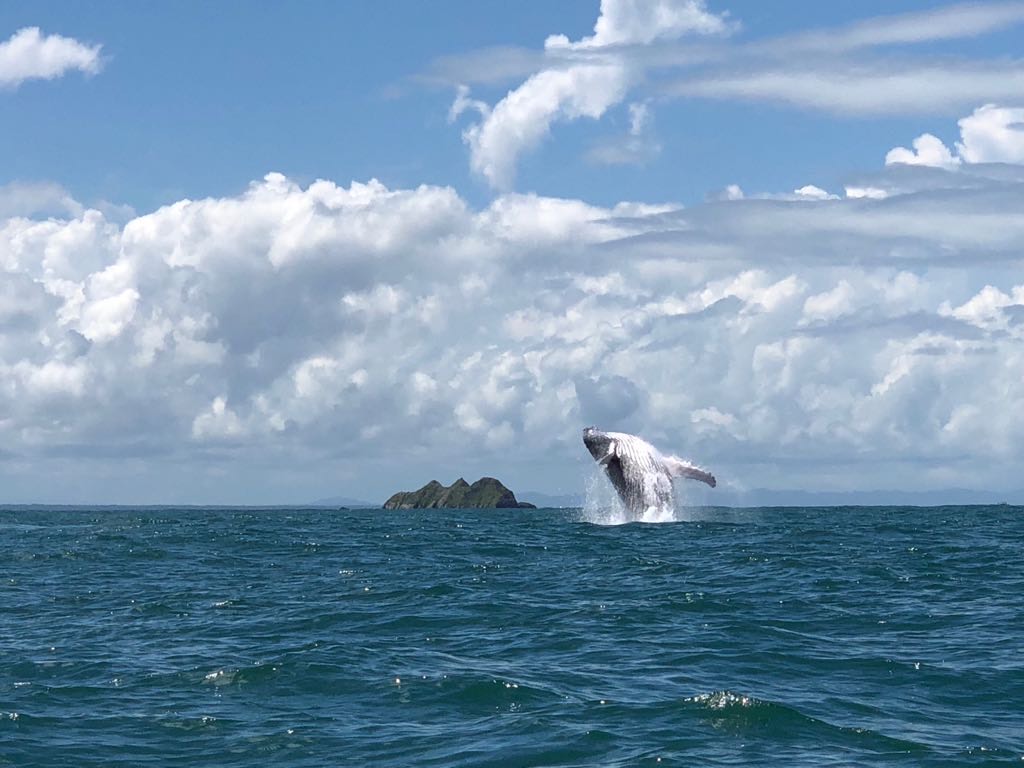It is the third most visited national park in Costa Rica; the economies of its neighboring communities are 95% dependent on tourism. However, when Costa Rica’s tourism activity shut down due to the pandemic, Marino Ballena National Park was already in the fourth year of another problem: it had been facing a closure order from health authorities since 2016 because it lacked adequate bathrooms or showers for its almost 200,000 annual visitors.
The park protects 5,160 marine hectares and 171 terrestrial hectares that correspond to a coastal strip of 15 km. It’s known for the whales that visit its waters every year, making it one of the best places in the world to see cetaceans—and also because on one of its beaches, the Uvita sector, there is a tombola that at low tide resembles the tail of a whale.
It’s hard to believe that such an iconic landscape, such a frequently visited park, has come so close to crisis. However, the devastating “zero season” caused by COVID-19, added to the closure order—which, while never enforced because of the importance of the park for many businesses in the area, and now stood in the way of Health Ministry approval for reopening during the pandemic—could have suffocated these local economies and therefore seriously affected their ability to contribute to the sustainability of the park.
You’d think that a global pandemic would only aggravate problems that already existed.
So how is it that in Bahía Ballena, in that unprecedented historical moment, found a new way to move forward?
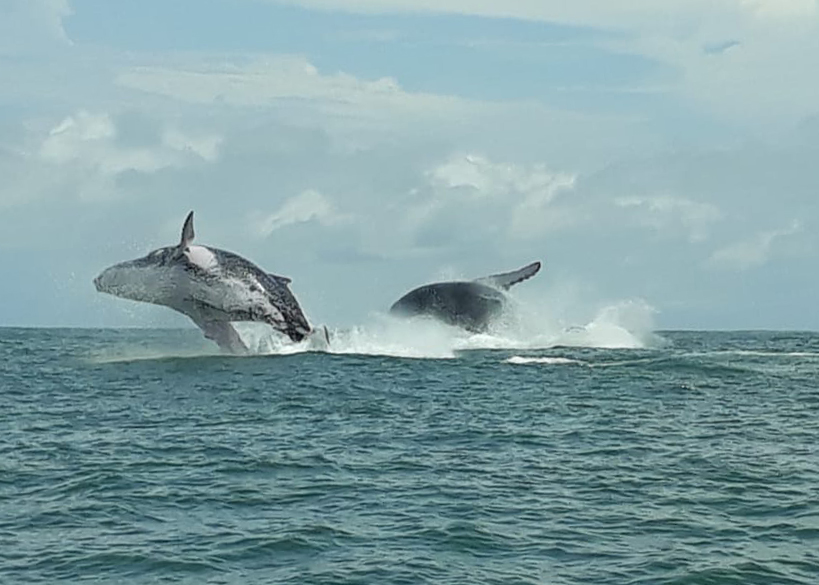
Marino Ballena before the pandemic
The first attempt to establish Marino Ballena National Park took place in 1989 via executive decree. However, the community presented a suit to try to stop this change, and the park was not officially created until a second decree was emitted in 1992. Its creation caused a huge upheaval in the community, because it put a stop to extensive commercial marine extraction, including trawling for shrimp.
The area was home to a community of artisanal fishermen who depended on the use of marine resources. What’s more, members of the many neighboring communities were used to coming and going on the beach as they pleased. A change of mentality about the use of resources took time, and engendered many confrontations between communities and authorities.
“You are taking the lobster away, but tomorrow that lobster will be worth more under a stone” where tourists can view it during a marine tour, Frank Sequeira recalls telling fishermen when he was a park ranger at Marino Ballena. “That lobster [on a tour] can be sold many times; it is sold only once on the plate.”
Frank is originally from Uvita and, as a community leader, has been actively involved in the evolution of the park.
“In a matter of five years, commercially valuable fishing had disappeared, and with it about about 70% of the fishermen,” says Frank. “Even so, the fighting continued.”
The history of the administration of the national park has three stages. Between the date of its creation and 1997, the management of the protected area was convulsive, full of confrontations and abandonments. For nine years starting in 1997, a community association called ASOPARQUE took over the administration and care of the park in conjunction with the National System of Conservation Areas (SINAC); this ended in 2006, when the Office of the Comptroller General of the Republic declared that this co-management between authorities and community was illegal, because Costa Rican law establishes that protected areas can only be managed by the state. As a result, SINAC took over the administration of the park once more.
Throughout, the mutual dependence between the protected area and the community has remained a constant factor. So, too, have confrontations.
“On two different occasions, people here have been so upset that they set fire to the park rangers’ house,” says Marcela Sequeira, president of the Uvita Integral Development Association (ADIU).
“This is a community that depends completely on a protected area, and that has grown economically from the park,” says Ana Camacho, executive director of the Somos Foundation, a community organization created in Bahía Ballena to support the region. “The lack of visibility of this symbiosis has caused a pointless divorce.”
The community leaders interviewed agree that the nine years under the administration of ASOPARQUE were the most organized and prosperous era in park management. However, that co-management was ruled illegal. The leaders also express enormous dissatisfaction with the park administration and the lack of resources that the government assigns to park management.
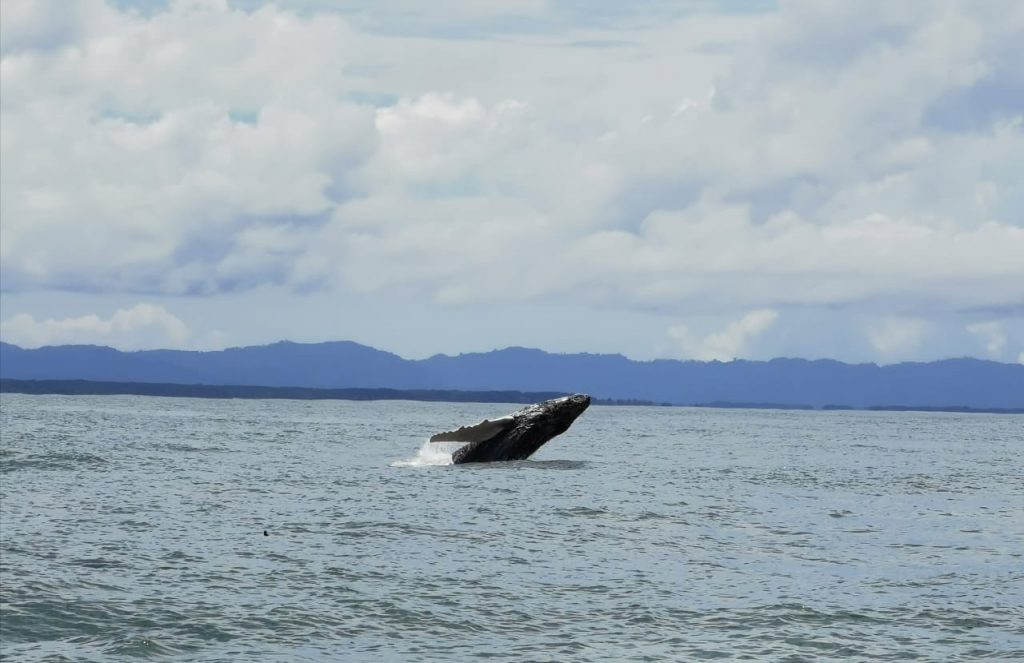
“We are the group that takes care of the park’s marine areas,” says Karol Monge, president of the Association of Tour Operators of Uvita (ASOTU), adding that SINAC does not have a boat to patrol the protected waters. “We have 40 [boats] and we do not allow people to fish within the park. If we see a turtle in danger, we help. We patrol and pick up trash.”
“In that park, everything is bad. Everything has to be changed,” says Marcela, from ADIU. “The conditions in which [SINAC] officials work are unbelievable. They’re conditions that the Health Ministry has said are unacceptable.”
According to Marino Ballena National Park Administrator Cristian Masis, pre-pandemic tourism data show that of every 10 tourists who visit Costa Rica’s protected areas, two visit Marino Ballena. However, resource allocation does not reflect this.
“The system is based on solidarity,” Cristian explains. “There are more than 100 protected areas, and only 46 charge for visitation. Of these, four generate 80% of the total visitation of protected areas in Costa Rica.” These are Manuel Antonio National Park, Irazú Volcano National Park, Marino Ballena, and Poás Volcano National Park.
When Cristian took over the administration of the park at the end of 2019, there were only nine officials assigned for the management and protection of the entire area. Today, there are 22 posts for this purpose, but, according to Cristian, this still represents only half of the personnel required to implement the park management plan.
The lack of resources and personnel within the protected area resulted in the order of closure from health authorities, but it had other consequences as well. Colonia Beach, which belongs to the park, became the area beach with the highest rates of theft.
“Tourists are very trusting, and when they returned [from a dip in the sea there was] nothing left,” says Cristian. However, “since we reopened [in 2020] we have not had a single crime.”
For Ana from Fundación Somos, apart from the lack of resources allocated to Costa Rica’s third most-visited protected area, the main problem faced by the dysfunctional symbiosis between the protected area and the community has to do with a lack of leadership on the ministerial level, high up in the Osa Conservation Area. In her view, the people in the view actually tend to find their way to a consensus, but they are limited by the legal “straitjacket.”
“Instead of valuing that discourse of sustainable economic development,” she says, “what [MINAE] does is try to see how to limit it.”
For all the people who spoke to El Colectivo 506, new, collaborative strategies are the only way to improve the relationships that define the park.
“Paths to fluid shared management must be found, because the government is running a deficit,” Ana says. “There is no other way out. We must generate mechanisms of interaction and mixed financing between the private sector, the communities and the state.”
“I dream of seeing Non-Essential Services and Activities (SANES), that involvement, that power of self-management,” says Cristian, the park administrator. “I dream of having park rangers who are attending tourists and the community guiding the tourist, the hotel [owner] telling the tourist what the rules are… so that the park rangers do not have to be” the only ones enforcing controls.
The pandemic’s unexpected impact
“He called us in April 2020, two weeks after they closed the park,” says Marcela. She’s referring to Cristian, who—in the first weeks of the pandemic—knocked on the doors of the ADIU, the Somos Foundation, and the Municipality of Osa, seeking resources to meet the health requirements necessary for an eventual reopening of the park.
Cristian explains that because public budgets are allocated a year in advance, the park did not have the necessary resources to address an unexpected emergency such as COVID-19.
“Everything had to be done,” says Marcela, referring to the bathrooms, urinals, showers, corridors and sinks. Through the ADIU, donations of money and labor from both public and private entities were directed toward the construction of the necessary facilities. Five months later, the Uvita area of the park started receiving visitors again.
“We helped them with protocols and donated all the labor for those bathrooms,” says Karol from ASOTU. “That’s where good relationships started. The pandemic has improved our relationship.”
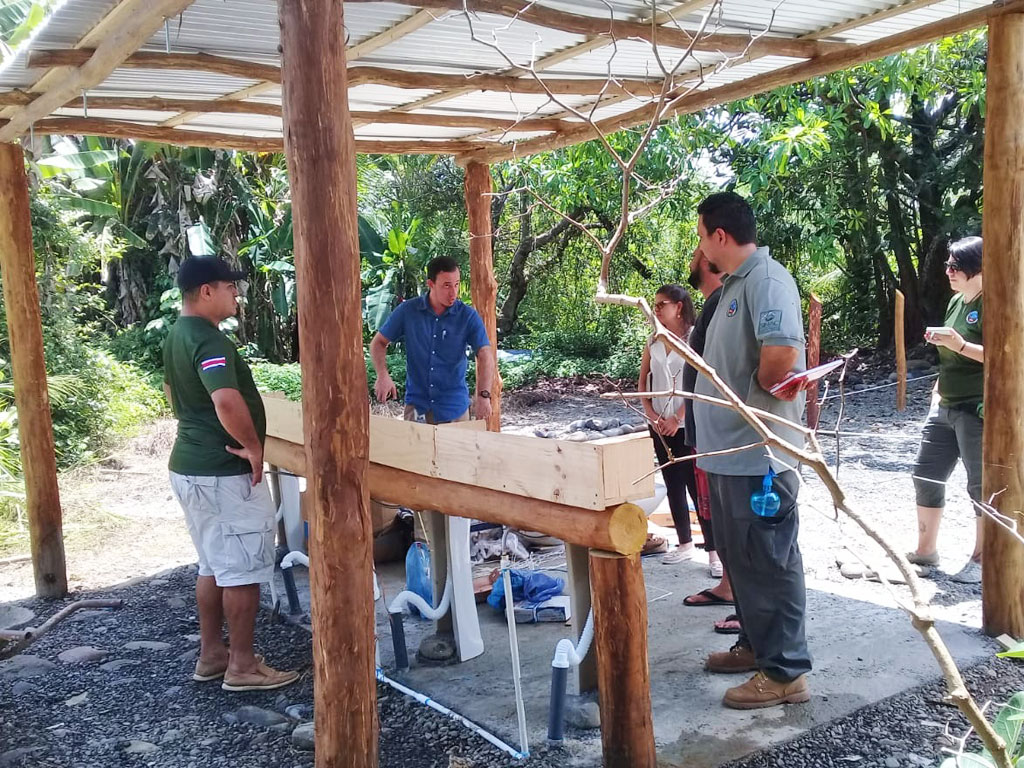
This teamwork made the Marino Ballena National Park the most visited in all of Costa Rica in 2020, reaching almost half of its normal visitation despite the pandemic. But what else was achieved?
In November 2020, an alliance of 13 community organizations in the Uvita and Ballena area was formally established. Since then, the alliance has become the new official channel of communication with the park administration.
The participating organizations are ADIU, the Bahía Ballena Guides Association (ASOGUIBA), Fundación KETO, Fundación Somos, the Central and Southern Pacific Friends of Nature Association (ASANA), the Administrative Association of Aqueducts and Sewers of Uvita and Ballena (ASADA) Uvita and Ballena, Viví Bahía Ballena (a group of merchants in the area), Cocos Association of the Marino Ballena National Park (ASOCOCO), Geo Porter, Coopeuvita RL, Sectional Union of Independent Producers and Various Activities (UPIAV) of Uvita de Osa, and TurisTica.
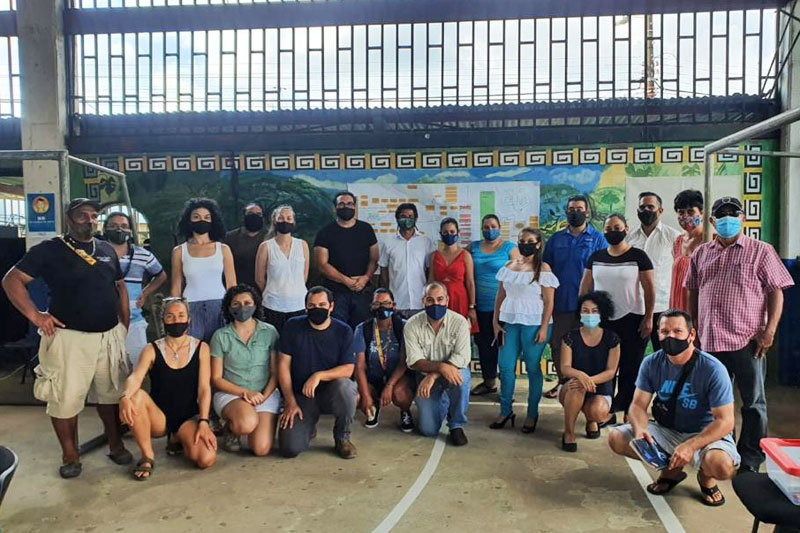
“We needed more community strength,” says Marcela. “We had to come together and see how, together, we could make things better.” And although the work of the alliance has focused on ensuring the opening of the park, Marcela says that the alliance hopes to continue working to achieve other projects in the area.
The capacity restrictions brought about by the pandemic also forced the alliance to organize another aspect of the park-community relationship.
According to article four of the Public Use Regulations of the Marino Ballena National Park, all residents of the communities of Ojochal, Piñuelas, Bahía Ballena, central Uvita, Playa Hermosa, La Unión and San Josecito have the right to enter the park without paying an entrance fee. This exemption is unique in all of Costa Rica, and was established as a way of recognizing the pre-existing relationship between the beach and the communities.
As of August 1, 2021, and at the request of the park administration, only people identified with a card issued by the ADIU are able to use this exemption. Before that, use of the exemption depended on whether a particular park ranger knew the community member personally, and the truthfulness of each visitor.
“We started printing cards in January,” says Marcela from ADIU. “We had to do many interviews, stories for [national] Channel 7. We had to do everything to try to explain to people that what we wanted was to save the exoneration.”
According to Cristian, the park allows 25,000 free resident visits a year under the exemption. He considers this a contribution to the community of 25 million colones (more than $40,000), in addition to the fact that resident operators of boating tours don’t pay for cabotage, or coastal transit rights.
“The park is a good neighbor,” he adds.
The community has had to change the way they visit the park. Due to the pandemic, fewer time slots for entry are available than usual, and visitation hours have been reduced. In addition, cars have been prevented from entering the beach, and camping is no longer allowed.
“We are happy with the park. We don’t want it to be just a public beach and nothing else,” says Marcela. However, she says that ensuring implementation of regulations, which should be the obligation of SINAC officials, has been difficult for communities to take on.
For Cristian, this arrangement has brought many benefits; the pandemic may not have been the cause, but it was an accelerator.
“This is a process that had to take place,” says Cristian, adding that the pandemic has affected all protected areas equally. “Here, we had already been working on this.”
“They want the park. They want the beach,” says Ana, recalling that the communities of the area have shown their willingness to contribute financially to help the park, before and during the pandemic. “They have a spiritual commitment, and it is reflected in a material commitment every time the park needs something.”
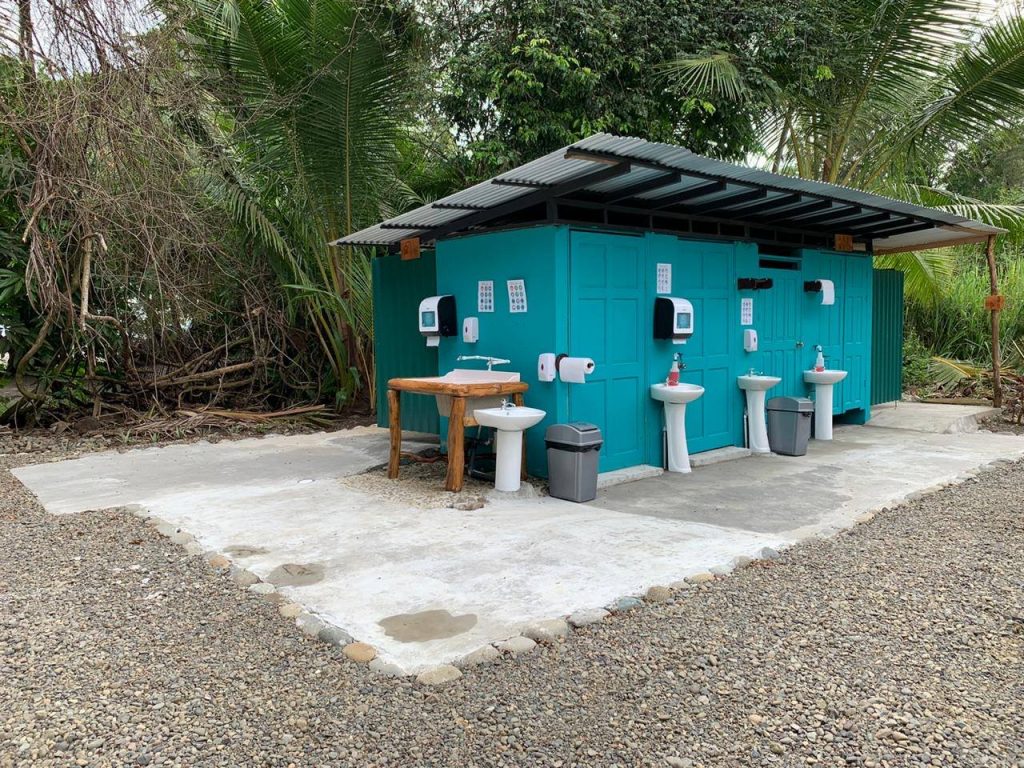
The doors that remain closed
“Just before the pandemic we were already starting to work well,” says Marcela, from ADIU. “During the pandemic, we got a lot stronger.”
That’s the conclusion of all the people interviewed by El Colectivo 506, who also agree that what has been achieved is only the beginning.
The park still needs many improvements, especially when it comes to infrastructure. At the end of February 2021, the necessary construction work began thanks to the investment of funds from the Development Board of the South Zone (JUDESUR), SINAC, the Municipality of Osa and the National Emergency Commission. With this investment, the park will add houses for park rangers, structures for visitor entrances, bathrooms and showers for visitors, and shops for basic goods and services for visitors (“tiendas de la naturaleza”) on most of its beaches.
What comes next on the priority list is organizing the management of the park within this new way of doing things. A consulting company is now conducting research for the new general management plan for the national park, a service that was donated by the Fundación Costa Rica por Siempre.
“We already did two very interesting workshops where we managed to get the [consultants] to listen to the community, thanks to the alliance,” says Marcela, who says community members requested that the plan prioritize visitation management. “You do need tourists in the parks, so let’s work on this issue.”
The other challenge for the protected area is to establish the Non-Essential Services and Activities (SANE) concessions that Cristian dreams of so vividly.
Karol, from ASOTU, tells El Colectivo 506 that ignorance about this new opportunity for a commercial relationship with the park scares organizations like hers, but that “the park is not obtaining income from the services provided”—referring to cabotage, the use of bathrooms and picnic areas, and water sports classes such as surfing and kayaking.
The implementation of the SANE would allow Marino Ballena National Park to receive a fee or payment from external entities that provide these services, as does the Chirripó National Park, as we reported in El Colectivo 506 earlier in this edition. This would provide the park with income that it could reinvest in infrastructure and improvements.
At the conservation level, Cristian hopes that work will continue on a coral rehabilitation project and the implementation of a Natural Resources Surveillance Committee (COVIRENAS) to improve joint community-SINAC work to protect national resources.
One more challenge for this recovering symbiosis has now emerged from the new Legislative Assembly building in San José. In December 2020, national legislator Gustavo Viales Villegas presented a Bill No. 22345, “Creation of the Marino Ballena National Park,” which seeks to enshrine the protection of the park in law, not just a decree.
However, the community organizations that surround Marino Ballena are now working to ensure that this law does not ignore more than 30 years of history, nor the massive advances of recent months. Through the alliance of organizations led by the ADI, they have made themselves heard.
“The good thing is that we have the lines of communication open,” says Marcela.


